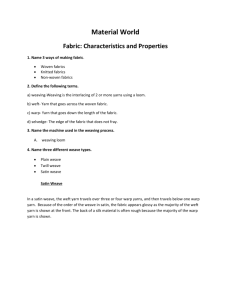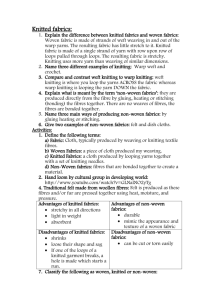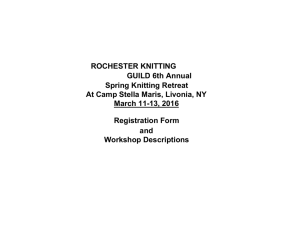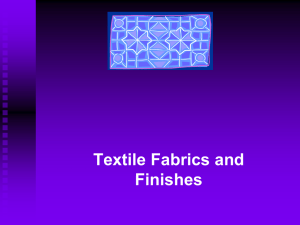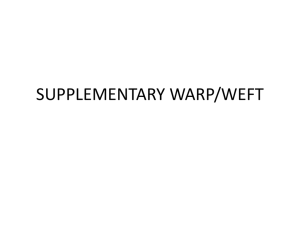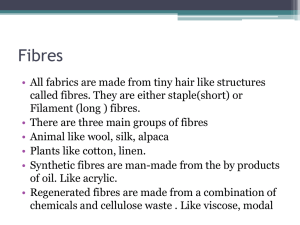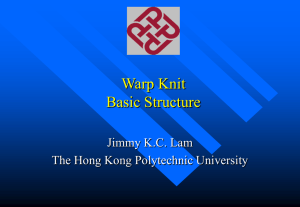HISTORY: - TEXTILE LIBRARY
advertisement
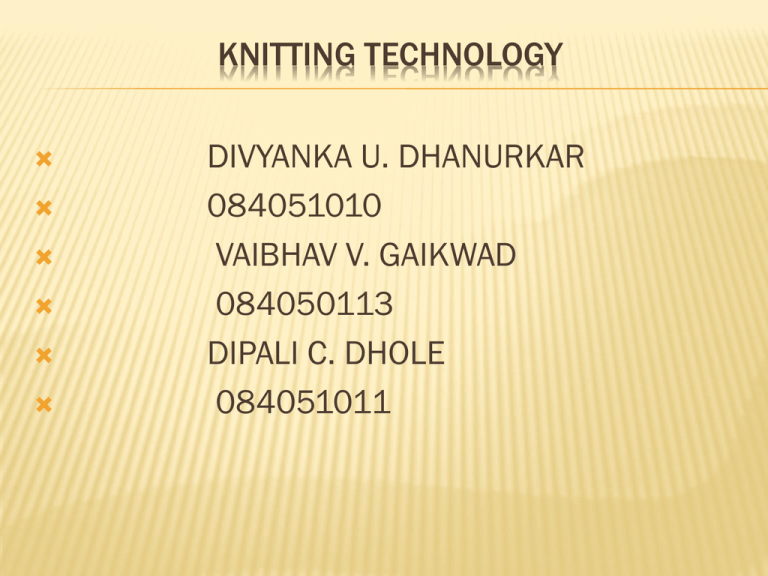
KNITTING TECHNOLOGY DIVYANKA U. DHANURKAR 084051010 VAIBHAV V. GAIKWAD 084050113 DIPALI C. DHOLE 084051011 INTRODUCTION Knitting is a process of manufacturing a fabric by the intermeshing of loops of yarns. The two main forms of knitting technology are Warp knitting Weft knitting KNITTING TERMINOLOGIES COURSES: Rows of loops across the width of the fabric produced by adjacent needles during the same knitting cycle. (measured in courses/cm). WALES: Vertical column of needle loops. Determines the width of the fabric (measured in Wales/cm). STITCH DENSITY: Represents the total number of needle loops in a given area. STITCH LENGTH: is the length of yarn in knitted loop. WEFT KNITTING Direction- horizontal WARP KNITTING Direction-vertical KNITTING NEEDLE TYPES CIRCULAR KNITTING MACHINE KNITTING CAMS Clearing cam/Rising cam Stitch cam Running cam/ upthrow cam Guard cams GENERAL LOOP FORMATION OF WEFT NEEDLE New yarn is taken Previous loop formed goes below the latch Needle goes to a maximum height The hook pulls the new yarn & loop is formed WARP KNITTING MACHINE LOOP FORMATION OF WARP KNITTING MACHINE Start of new course Start of overlap Guide bar swinging motion Return swing after overlap Old loop closing latch Knock over & underlap movements WARP KNITTED STRUCTURES FULL TRICOT LOCKNIT THREE NEEDLE SHARKSKIN THREE NEEDLE QUEENSCORD BASIC WEFT KNITTED STRUCTURES Simplest & most widely used weft knit structure Fabric unroved from end Fabric tends to curl at the edges Production rate is high RIB KNIT STRUCTURE It is reversible structure It gives a balanced structure Fabric does not curl Maximum extensibility in widthwise direction Rib structure can not unroved PURL KNIT STRUCTURE Consists of reverse & face courses Very little commercial & apparel end use Extensibility in length wise direction Fabric does not curl Suitable for socks & sportswear INTERLOCK FABRIC It gives a reversible appearance Fabric is firm It does not curl at edges Production rate is reduced to half Structure is thicker, stronger & less elastic Cost of fabric is high COMPARISON OF WEFT & WARP KNITTING Weft knitting Warp knitting Yarn are fed course wise direction Yarns are fed wale wise direction Yarn supply is usually in the form of a cone or cheese Yarn is in one long beam or small warp beams Staple fibre & continuous filament yarns used Filament yarns can be successfully worked Usually latch needles are used Latch, beard or compound needles are used Only one class of goods can be knitted Variety of goods can be knitted Extensibility in widthwise & lengthwise direction It stretch in widthwise direction FACTORS AFFECTING ON DIMENSIONAL PROPERTIES Fabric structure Fibres type Stitch length Relaxation Yarn linear density COMPARISON BETWEEN WOVEN, KNITTING AND NON-WOVEN WOVEN KNITTING NON-WOVEN Is the process in which two sets of yarns or threads are interlaced together to form a fabric or cloth. Fabrics are created by looped yarns. Is a material made from long fibers, bonded together by chemical, mechanical, heat or solvent treatment. WOVEN KNITTING NON-WOVEN The threads are always straight and perpendicular to each other The yarn follows a course, or a path, forming wellproportioned loops over and under the yarn’s path. The fibres are parallel bonded together. Made of two sets of individual strands. Made of one continuous thread. No thread or yarn required as it is made directly from fibres. Has the ability to be more versatile in its construction. Is tougher and better able to withstand wear WOVEN KNITTING NON-WOVEN Have fast colors and are more durable than knitted fabrics that shrink easily. Two types of threads run in different directions, with the warp threads running lengthwise, and the weft threads running crosswise or has a horizontal direction. Preferred for comfort and wrinkle resistance Used for technical purpose. It consists of stitches, or loops of the material consecutively run together. Fibre laps are placed over other. Include satin, twill, plain weave. Include jersey, Berber, mesh, toweling, felt and fleece No weave requires. WOVEN KNITTING NON-WOVEN Fabrics feel less soft than knit fabric Fabrics are smooth, flexible and move with the body Feel is good, soft. Less stretch and does not shrink. It is stretch and shrinks. Does not stretches. Has high strength Has less strength Has lack of strength. Has less elasticity Has more elasticity. Has no elasticity. Products have more flow and much thinner. Products are more elastic and bulkier Products are thicker, thinner and bulkier. Involves a bigger and heavier piece of equipment the loom. Requires smaller materials, like knitting needles. Also involves a bigger and heavier piece of equipment the WOVEN KNITTING NON-WOVEN e.g. suiting, shirting, sari, dhoti, bed sheets etc. e.g. t-shirts, socks, bandages, sweaters, jersey and terrycloth etc. e.g. filters, felts, blankets, interlings, disposable material, geotextile, cement bags, coating cloth etc. APPLICATIONS OF KNITTED FABRIC Geotextiles Coverings Safety textile Industrial textile Medical textile Composites sportswear Nets MARKETS FOR TECHNICAL TEXTILES The world produces over 17 tons of knitted textiles and apparel - representing one third of the global textile market. Moreover, output is forecast to grow by 25% over the next ten years, reaching more than 21 tons. COST OF FABRIC Fabrics Cost(US$) 100% polyster grey towel cloth knit fabrics for track suits. US $1-5 / Kilogram Sportswear/ shoes polyester knit mesh fabric. US $0.1-2.9 / Meter 100%polyster knitting fabric for sportswear. US $9.5-10 / Kilogram Flame Resistant Knitted Fabric for Safety Clothing. US $12.5-16 / Kilogram Knitted mattress fabric. US $1.99-3 / Meter
